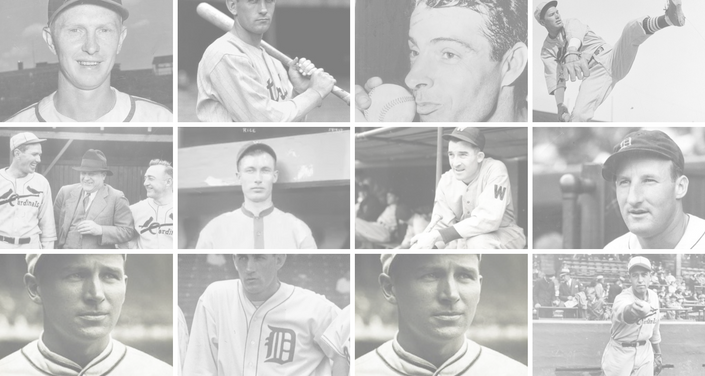Six years earlier, the Cubs copped the NL championship after dismissing Rogers Hornsby as manager in early August and replacing him with Charley Grimm. The Yanks, with McCarthy in command in ’32, coasted to the pennant by a 13-game margin.
Fortunately for the Yankees and unfortunately for the Cubs, the similarities didn’t end there. As in 1932, the New Yorkers were invincible in the World Series.
The Yankees had reached the 1938 World Series in typical crunching fashion. Five New York regulars compiled RBIs totals exceeding 90, and those five — Joe DiMaggio, Bill Dickey, Lou Gehrig, rookie Joe Gordon and Tommy Henrich — had home-run figures ranging from 32 to 22. Red Ruffing led the American League in victories with 21, followed in the rotation by Lefty Gomez (18 wins), Monte Pearson (16) and Spud Chandler (14). The result was a 9 1/2-game lead over the Boston Red Sox in the AL.
The Cubs made it to the Series on a late charge that featured one particularly dramatic moment. On September 28, as darkness descended on Wrigley Field, Chicago manager Gabby Hartnett walloped a two-out, ninth-inning home run that lifted the Cubs to a 6-5 victory over Pittsburgh and enabled the North Siders to slip past the Pirates into first place. Until Hartnett’s homer — which gave Chicago a half-game lead in the standings — the Pirates had been atop the National League for 2 1/2 months. The Cubs held on to first place, winning the pennant by two games.
Hartnett, the Cubs’ 37-year-old catcher, had been thrust into the managerial role three weeks into July as successor to the deposed Grimm. As in 1932, the Cubs had dipped into their player ranks upon naming a new manager (Grimm, strictly a dugout manager beginning in 1937, was the Cubs’ first baseman when he took over in ’32).
While Hartnett obviously lit a fire under these Cubs — the club was in a virtual tie for third place when he became manager — he had no powerhouse. First baseman Rip Collins led the team in homers with 13, and outfielder Augie Galan topped the Cubs in RBIs with 69. While the thunder was missing, third baseman Stan Hack and outfielder Carl Reynolds at least provided some lightning. Hack batted .320 and led the National League with 16 stolen bases, and Reynolds hit .302. Bill Lee and Clay Bryant were the staff pitching aces with 22 and 19 victories. Dizzy Dean, who tried to come back too soon after his All-Star Game toe injury of 1937 and hurt his arm, had been obtained from the St. Louis Cardinals in April and won 7-of-8 decisions.
Lee got the call for the Cubs in the Series opener. And while the big righthander pitched relatively well, he did not pitch well enough to win. Dickey went 4-for-4 against him, scoring a run and driving home another, and the Yankees jumped on top in the fall classic with a 3-1 triumph.
Game 2 was emotion-packed as the brash Dean, pitching mostly on guile, contained the Yankees for seven innings at Wrigley Field. 0l’ Diz, changing speeds and using his experience, had given up only three hits and led 3-2. George Selkirk collected the Yankees’ fourth hit as the leadoff batter in the eighth, but two force outs left Dean in a position to escape unharmed. Frankie Crosetti, the low man on the Yankee regulars’ home-run list in 1938 with nine homers, was up next with Myril Hoag inching off first base. Crosetti promptly sent shudders through the crowd, laying into a Dean pitch and driving it into the left field stands. Yankees 4, Sentimentality 3.
While 0l’ Diz, a 27-year-old righthander, struck out Red Rolfe to end the eighth, he couldn’t get through the ninth. Henrich began the inning with a single and DiMaggio dashed Dean’s and the Cubs’ hopes by following with a home run. Gomez was credited with the 6-3 victory, his sixth and last in Series competition against no defeats.
Ahead two games-to-none with the Series shifting to Yankee Stadium, the New Yorkers seemed to be a lock. And they were.
Gordon rapped a bases-empty homer and a two-run single in Game 3, leading the Yankees to a 5-2 victory. Crosetti flexed his muscles again in Game 4, driving in four runs with a double and a triple as New York completed its fourth sweep in its last six World Series appearances. The stinging 8-3 defeat in the finale meant the Cubs had finished on the short end in their last six Series.
While the Yanks’ sweep was yet another similarity to 1932, one aspect of the ’38 Series bore no resemblance to what had transpired six years earlier. Gehrig, who slugged three homers and drove in eight runs in the ’32 fall classic, neither hit a homer nor collected an RBI this time around. He managed four hits, all singles, in 14 at-bats in his last Series.
Gehrig’s legacy was many-faceted, and it included the fact he had just become a member of the first team to win the World Series in three consecutive years.


